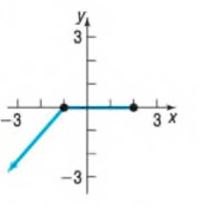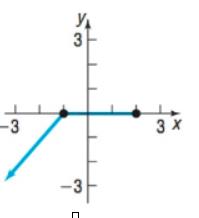
Concept explainers
In Problems 33-44, the graph of an equation is given. (a) Find the intercepts. (b) Indicate whether the graph is symmetric with respect to the , the , or the origin.

To find: The intercepts and to indicate whether the graph is symmetric with respect to the , and the origin.
Answer to Problem 42AYU
The intercepts are , . There is no symmetry.

Explanation of Solution
Given:
The graph of an equation
Calculation:
From the given graph, we can identify that the intercepts are and . The have coordinates equal to 0.
There is no symmetry in the given graph.
Chapter 1 Solutions
Precalculus Enhanced with Graphing Utilities
Additional Math Textbook Solutions
University Calculus: Early Transcendentals (4th Edition)
Elementary Statistics (13th Edition)
College Algebra with Modeling & Visualization (5th Edition)
Elementary Statistics
Pre-Algebra Student Edition
- Question 2 If A(t) = 3t² i − (t + 4); + (t² - 2t)k and B (t) = sinti +3ej-3 cos tk, find (A x B) at t-0 dta Ans: -301+14j + 20karrow_forwardQuestion 2 If A(t) = 3t² i − (t + 4); + (t² - 2t)k and B (t) = sinti +3ej-3 cos tk, find (A x B) at t-0 dta Ans: -301+14j + 20karrow_forward6. Find the angle to the nearest degree between the two planes given by x-2y+2=0 and 2x+3y-22-0arrow_forward
- Q2/ If x is directly proportional with (y) and (x = 8) when (y = 15), then what is (x) equals when (y = 10).arrow_forwardConstruct 6X9 matrix with nullity 2arrow_forwardCalculate the following integrals, subject to the following rules: ⚫ you must use integration by parts at least once (clearly labeling where it is used), • you must use a partial fraction decomposition at least once (clearly showing all steps), and • you must use a trigonometric substitution at least once A. A/2² x² ex cos xdx √20 20-22 B. -dz z4 x² - C. x3 - 2x2 2x2 - 2x + 3 3x6 linear term and quadratic term) dx (Hint: the denominator factors into aarrow_forward
- please evaluate both of the given integrals and state the technique used for integrals like this when they break the definition of a definite integralarrow_forwardFor what values of p is the following series convergent? Justify your answer. ∞ (−1) k-1 (In k)P k k=2arrow_forwardPlease find the power series representation of h(x) as well as the IOC. You can use table of Maclaurin Series. What is the h^(83) evaluated at x=0arrow_forward
- Consider the following integral: In(1 + x¹)dx In(1 A. When we first learned how to integrate / In(x) da we used the IBP technique. As far as you are able, please use the IBP technique to integrate In(1 + x4)dx. In B. Why did the IBP fail here? C. Without using a table of Maclaurin Series, represent f(x) = ln(1+x4) as a power series and find the IOC. D. Without using a table of integrals, please use the series you found 4 above to calculate / In(1 + x²)dx.arrow_forwardLet f(x) = k(5x − x²) if 0 ≤ x ≤ 5 and f(x) = 0 if x 5. - (a) For what value of k is f a probability density function? k = (b) For that value of k, find P(X > 1). P(X > 1) = (c) Find the mean. μ =arrow_forwardIn this project, you will use spreadsheet software (either Microsoft Excel or Google Sheets, please) or Desmos explore the Sine Integral function (sin(t)/t, t0 t = 0° Si(x)=s sinc(t)dt, where sinc(t): 1, to By using the Midpoint, Trapezoid, and Simpson's Rules with n = 20, you will approximate the value of Si(5). You will also use a Taylor Series representation of Si(x) to approximate Si(5). Answer the questions below (either print this page or write or type on your own document). You will need to submit your answers as well as your spreadsheet and/or Desmos graph link. Make sure that your spreadsheet/Desmos graph is very well-organized so that I can look at it to see how you performed each calculation. If you need help using the technology, see me in office hours, ask your classmates, see a tutor, or seek tutorials on the internet. 1. Use the Midpoint Rule to approximate Si(5) with n = 20. Write the approximation here with at least 8 digits after the decimal. 2. Use the Trapezoid Rule…arrow_forward
 Calculus: Early TranscendentalsCalculusISBN:9781285741550Author:James StewartPublisher:Cengage Learning
Calculus: Early TranscendentalsCalculusISBN:9781285741550Author:James StewartPublisher:Cengage Learning Thomas' Calculus (14th Edition)CalculusISBN:9780134438986Author:Joel R. Hass, Christopher E. Heil, Maurice D. WeirPublisher:PEARSON
Thomas' Calculus (14th Edition)CalculusISBN:9780134438986Author:Joel R. Hass, Christopher E. Heil, Maurice D. WeirPublisher:PEARSON Calculus: Early Transcendentals (3rd Edition)CalculusISBN:9780134763644Author:William L. Briggs, Lyle Cochran, Bernard Gillett, Eric SchulzPublisher:PEARSON
Calculus: Early Transcendentals (3rd Edition)CalculusISBN:9780134763644Author:William L. Briggs, Lyle Cochran, Bernard Gillett, Eric SchulzPublisher:PEARSON Calculus: Early TranscendentalsCalculusISBN:9781319050740Author:Jon Rogawski, Colin Adams, Robert FranzosaPublisher:W. H. Freeman
Calculus: Early TranscendentalsCalculusISBN:9781319050740Author:Jon Rogawski, Colin Adams, Robert FranzosaPublisher:W. H. Freeman
 Calculus: Early Transcendental FunctionsCalculusISBN:9781337552516Author:Ron Larson, Bruce H. EdwardsPublisher:Cengage Learning
Calculus: Early Transcendental FunctionsCalculusISBN:9781337552516Author:Ron Larson, Bruce H. EdwardsPublisher:Cengage Learning





